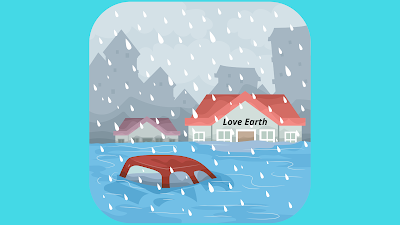What Is Flood? Definition, Cause and Impact
Flash floods or floods are large floods that come suddenly by overflowing, inundating, and flowing large objects (such as wood and so on). [1] This flood occurs suddenly in a low surface area due to continuous rain. Flash floods occur when the water saturation of the soil in the area is so fast that it can no longer be absorbed. The stagnant water then collects in areas with low surfaces and flows rapidly to lower areas. As a result, all kinds of objects in his path were suddenly surrounded by water. Flash floods can cause huge losses.
When did the flood occur?
Floods occur at irregular intervals and vary in size, duration and area affected.
Water always flows naturally from high to low areas. This means that in the lowlands there can be flooding faster before it reaches higher ground.
Floods can occur suddenly and subside quickly. But some things happened for days or even longer.
What causes flooding?
When floods occur in areas inhabited by humans, water carries objects such as houses, bridges, cars, furniture and even people.
The force of flooding can damage agricultural land, dragging trees and heavy objects.
Rain
Whenever there is heavy rain and it exceeds the capacity of the drainage system, flooding will occur.
Sometimes heavy rains in a relatively short period of time can cause flooding.
Other times, days or weeks of light rain can result in flooding.
The river was overflowing
Overflowing rivers can cause flooding.
River overflows can occur when there is more water upstream than normal.
When the water flows downstream towards the adjacent lowlands, there will be bursts and the water will enter the land.
Storm and strong wind on the beach
Sea water can be carried by strong winds and hurricanes onto dry coastal plains, causing flooding.
Conditions can be worse if the wind also brings its own rain.
Sometimes water from the sea as a result of the tsunami can flow inland and cause damage.
the embankment or dam is broken
Embankments are built on the side of the river and are used to prevent high water from flooding adjacent land.
A dam is an artificial beam that is installed to withstand the flow of water from the highlands. The power from water is used for electricity generation.
But if too much water is retained in the dam it can cause the dam to overflow and the water to overflow.
Excess water can also be deliberately drained from the dam to prevent dam damage resulting in flooding.
Ice and snow melt
In cold regions, heavy snow during winter usually remains un melted for some time
There are also mountains that have ice at the top.
Sometimes the ice suddenly melts as the temperature rises, resulting in a large movement of water into places that are normally dry.
Drainage blockage
Floods can occur when snowmelt or rain runoff is not properly channeled into the drainage system resulting in water flowing inland.
Blockage of drainage or inadequate drainage system is usually the cause of this type of flooding.
Areas where drainage is blocked will remain flooded until the rainwater system or drains are repaired.
Flood impact
The occurrence of floods has consequences that have an impact on the economy, environment and humans.
The following are some of the problems caused by flooding, including:
- Economy
During floods, especially flash floods, roads, bridges, agriculture, houses and cars are destroyed. People become homeless.
The government deployed firefighters, police and other emergency equipment to assist the victims.
All these efforts must be paid handsomely for the community and government.
It usually takes a long time for flood-affected communities to rebuild.
Likewise, businesses that take a while to return to normal. - Living environment
The environment is also negatively affected when flooding occurs.
Chemicals and hazardous substances usually end up in water and pollute water bodies which eventually flood them.
For example, a large tsunami hit Japan and seawater inundated part of the coastline in 2011.
The floods caused massive leaks at the nuclear plant and have since caused high radiation levels in the area.
Authorities in Japan are concerned that Fukushima Nuclear radiation levels are 18 times higher than expected.
In addition, flooding causes animals to be killed which disturbs the natural balance of the ecosystem. -
Humans and animals
Many people and animals died in flash floods. In addition, many were injured and left homeless.
The supply of water and electricity is disrupted so that it has an impact on human activities.
In addition, floods carry many diseases and infections including fever, plague pneumonia, dermatopathia and dysentery.
Animals such as snakes and insects can be carried away by flooding and cause chaos when passing through residential areas.
Are there any positive impacts of flooding?
Although the occurrence of floods causes many losses to human life, there are positive impacts of flooding, especially if it occurs in floodplains and agricultural fields.
Flood water carries a lot of nutrients stored on the plains. This nutritious soil is considered perfect for farming.

Post a Comment